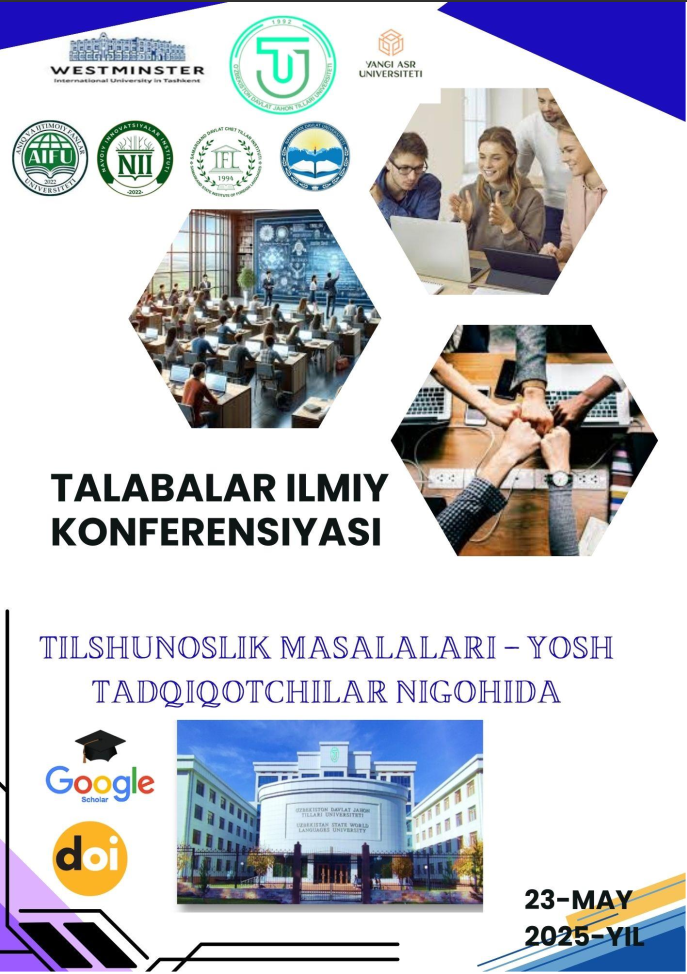CHARACTER CONSTRUCTION IN LITERATURE: A STYLISTIC APPROACH
https://doi.org/10.5281/zenodo.15517300
Kalit so‘zlar
Character construction, literary style, stylistic devices, characterization, narrative structure, dialogue, diction, language use, literary analysis, symbolism, metaphor, irony, character development, narrative techniques, literary criticism, thematic analysis, psychological depth, literary genres.Annotasiya
Character construction in literature is a vital aspect of storytelling that significantly shapes the reader's engagement and understanding of a narrative. Through a stylistic approach, this article explores the various methods and techniques employed by authors to create and develop memorable, multidimensional characters. It examines how elements such as language, tone, diction, dialogue, and narrative structure contribute to the characterization process. By analyzing literary works from different genres, the study demonstrates how stylistic choices influence the portrayal of characters, revealing their personalities, motivations, and relationships with other elements of the story. Furthermore, the article investigates how stylistic devices, such as symbolism, metaphor, and irony, play a role in deepening the reader’s perception of characters and their development throughout the plot. This approach highlights the interconnectedness between stylistic features and character development, illustrating how authors craft characters that resonate with readers on emotional, psychological, and thematic levels. Ultimately, the article underscores the importance of style in the art of character construction, offering insights into how writers use language and form to bring their characters to life and convey complex human experiences.
Foydalanilgan adabiyotlar ro‘yhati
Abrams, M. H. (1999). A Glossary of Literary Terms. Boston: Heinle & Heinle.
Abulkasimovna, E. Z., & Leonidovna, M. N. (2023, March). THE LEXICAL-SEMANTICAL USAGE OF PROFESSIONAL LEXEMES IN “UTGAN KUNLAR”(" PAST DAYS") BY ABDULLA QADIRI. In International Scientific and Current Research Conferences (pp. 20-22).
Alimdjanovna, K. M. (2024). METAKOGNITIV YONDASHUV ASOSIDA INGLIZ TILINI O ‘QITISH. Бюллетень педагогов нового Узбекистана, 3(2), 113-117.
Chatman, S. (1978). Story and Discourse: Narrative Structure in Fiction and Film. Ithaca: Cornell University Press.
Cuddon, J. A. (2013). A Dictionary of Literary Terms and Literary Theory. 5th Edition. Oxford: Wiley-Blackwell..
El Agez, B., & Rashidova, G. I. (2024). Authentic materials for teaching writing: a critical look. O ‘zbekiston davlat jahon tillari universiteti konferensiyalari, 21-30.
Fowler, R. (1986). Linguistic Criticism. Oxford: Oxford University Press.
Gulomova, R. (2017). The importance of fairy tales in teaching English as a second language. Архивариус, 1(2 (17)), 27-29.
Leech, G. N., & Short, M. H. (2007). Style in Fiction: A Linguistic Introduction to English Fictional Prose. 2nd Edition. London: Pearson Education Limited.
Rahimberdiyeva, A., & Muhtashamova, P. (2024). Teaching methods in mixed ability classes. O ‘zbekiston davlat jahon tillari universiteti konferensiyalari, 166-169.
Rimmon-Kenan, S. (2002). Narrative Fiction: Contemporary Poetics. 2nd Edition. London: Routledge.
Simpson, P. (2004). Stylistics: A Resource Book for Students. London: Routledge.
SULTONOVA, M. (2024). On the issue of critical thinking.
Toolan, M. (1998). Language in Literature: An Introduction to Stylistics. London: Arnold.

